评估成人脊柱平衡与否,这几项参数是标准(下)
2020-10-27 文章来源:《脊柱矢状位平衡》 我要说
使骨盆围绕股骨头旋转是身体维持脊柱矢状位平衡重要的代偿机制。如果骨盆入射角(pelvisinc idence,PI)很小,骨盆则不能很好地围绕股骨头进行旋转。因此,形态学定义了骨盆的旋转能力及矢状位失平衡的代偿能力。
需要知道的是因为骨盆入射角因人而异,所以理解失平衡代偿机制不应仅限于了解骨盆倾斜角(pelvictilt,PT),绝对不可以单纯通过骨盆倾斜角来定义脊柱是否是平衡。
许多学者尝试整合这些参数以探索脊柱平衡和非平衡之间的界限。一些参数,如骨盆入射角-腰椎前凸角(PI-LL)的匹配情况似乎可以定义大部分失平衡,但是由于病理改变情况错综复杂,还要取决于不同参数同骨盆入射角的关系。
骨盆入射角的变异对骨盆倾斜角和骶骨倾斜角的影响
PI角、SS角和PT角呈几何相关,即PI=PT+SS。当SS角趋近于0°时,PT角趋近于PI角。骨盆前倾(PT角减小,SS角增加)或骨盆后倾(PT角增加,SS角减小)使人类能够消耗最少的能量以保持双足站立。这种使骨盆围绕股骨头旋转的功能是维持脊柱矢状位平衡的重要代偿功能之一。骨盆后旋(PT角增加)使SS减少以适应腰椎前凸角度,以此令躯干后移以对抗重力性前倾。
理论上讲,PI角大的患者这种代偿能力更强[22](图5-7)。换言之,PI大的时候骨盆后旋可能性更大。骨盆后旋能力是评估ADSD的重要指标之一。骨盆PI角小,围绕股骨头后旋能力越差(图5-8)。因此,形态学定义了骨盆旋转能力及保证脊柱矢状位平衡代偿能力。骶骨上终板方向或多或少的倾斜(如L5/S1椎间盘一样)影响着整个脊柱矢状位立线,PI角越大,SS角和LL越大[22]。
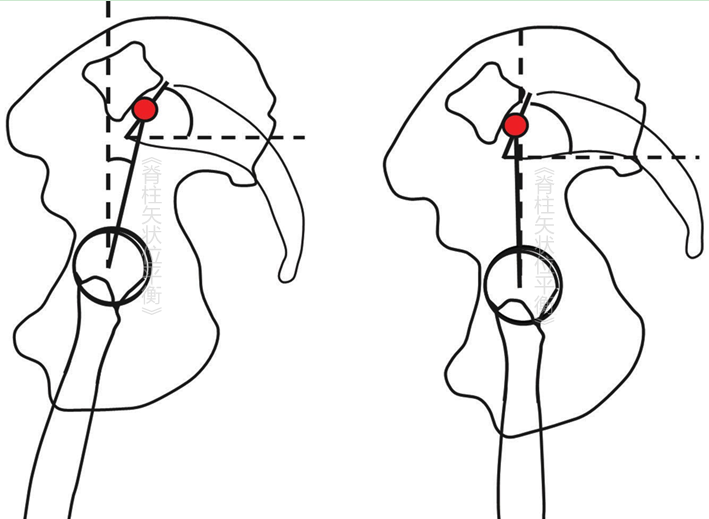
图5-7 当髋部固定时前屈或腰椎过度前凸时,骨盆处于前倾状态,PT减少SS增加
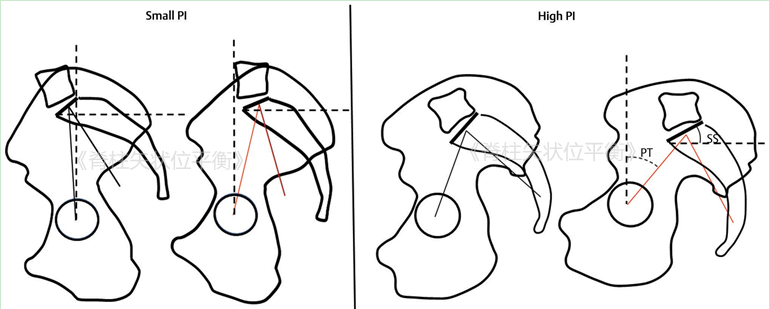
图5-8 PT的变异同PI相关
PI较小时,骶骨上终板位于股骨头上方,同髂嵴投射位置相近;当PI较大时,骶骨看起来似乎较小,骶骨上终板位于股骨头后方,相对于髂嵴位置更低
骨盆入射角、骶骨倾斜角和远端脊柱前凸之间的关系
如前文所述,远端脊柱前凸的下弧角(DSL)等于骶骨倾斜角(SS),第6章将讨论在无症状患者中DSL的上弧角是几乎是恒定的。然而,SS角同DSL之间存在着很大的关联性(R=0.86)。
值得注意的是,DSL的广泛变化仍然存在SS范围内。因为PI角同SS角的变化密切相关,这似乎佐证了DSL同样随着PI角变化。PI角同大DSL或者LL成很大的正相关性,反之亦然。
这种发现(及PI-LL不匹配用于临床评估脊柱平衡)可能在许多情况下都是正确的,但是在下一章中我们将看到,它并不是适用于所有情况。
矢状位平衡的整体评估
认识脊柱整体平衡的目的是将颈、胸、腰椎的顶部区域与骨盆的形状和/或位置联系起来。经典的方法是选择颈7椎体的中间部分。在第3章,Vital等提出了内耳传导,包括颈椎和颅骨的整体平衡评估[11]。其他研究则关注于现在可数字化成像更清晰的T1椎体。法国学者Duval-Beaupère[28]选取T1为重心因为其接近全脊柱重心。在远端,主要解剖学标志为骶骨上终板(边界和中心点)及股骨头(重心和双侧股骨轴)。不同参数已经通过长度和角度加以描述。
长度分析容易产生误差的原因有两个。第一,测量两点间的准确距离需要一个精确校准的影像,临床中很难实现。第二,成像比例问题,如对比高大的男性和矮小的女性就不太合适。所以应用长度比值就可以避免之前两种问题。这样无须校准,使一个点同另外两个点的相对定位,可以忽略尺寸比。
空格角度对比时无须校准影像,但是尺寸比可能会使角度产生偏移。在很小的角度和很小的变化下,可以人为获得很好的关联性。依靠解剖线所画出的角度是形态或形状成角;在解剖线和方向参照线(垂直或水平)之间测量的是位置角(图5-11)。先前描述的角度上增加90°或180°并不会改变角度的含义,但有时它可能有助于对脊柱更好的几何理解。脊柱的整体平衡已被广泛研究,并出现了几种形式的描述。
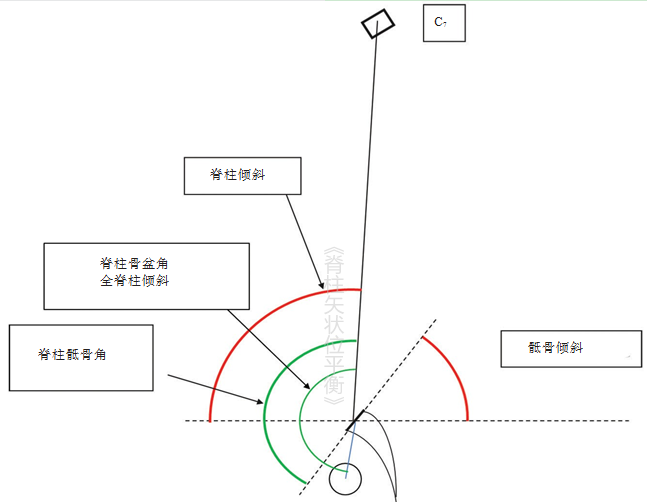
图5-11 通过C7评估脊柱平衡
红色范围为位置角,绿色范围为形态角
T9倾斜角:Duval-Beaupère定义这个参数为表示通过身体中轴位的脊柱矢状位平衡[16,9,20]。T9倾斜角是经过T9中心点的垂线同T9中心点和股骨头中心点连线之间的夹角。反映脊柱矢状位平衡主要依靠3个因素,即PI、LL和SS的线性组合,以及PT和TK。
C7铅垂线:C7椎体在绝大多数脊柱侧位片上都是清晰可见的。文献回顾证明这一参数是反应全脊柱平衡可靠和稳定的指标[29]。C7铅垂线为经过C7中心点的垂直线,医师需要分析这条线同骶骨上终板后缘之间的距离。因为T1椎体有时并不可见,C7铅垂线便成为更好的测量方法。
脊柱的整体影像学评估受限依赖于身体部位是否充分成像,如上肢、脸部及髋部的位置。C7椎体标记出来,然后从椎体中心点引一条垂直于地面的垂线。应用C7铅垂线评估脊柱矢状位平衡有3种方法。
距离测量:SVA广泛应用于测量脊柱矢状位平衡,SVA即C7铅垂线至骶骨上终板后上缘的垂直距离。Schwab等[30]定义5cm为脊柱矢状位平衡的临界值。但是众所周知影像学测量易于出现误差。不精确的校准会导致错误的分析。当C7铅垂线位于骶骨后上缘前方时,SVA为正值,反之为负值。
角度测量:从C7中点至骶骨上终板中点画一条线,则可以确定2个角度。
C7倾斜角为一个位置参数,在无症状患者中这个角是恒定的,范围在3°~5°后倾。
脊柱骶骨角(spino sacral angle,SSA)是由Roussouly[31]提出的一个形态学参数,其为骶骨上终板线同C7中心点和骶骨上终板中心点连线的夹角。其定义了脊柱不包含颈椎的整体后凸角度。在无症状患者群中,SSA同SS有着非常强的关联性,指的是在正常情况下,身体努力使C7的垂直线与骶骨保持平衡。SSA给出了脊柱整体后凸的值并在脊柱出现后凸时减小。其可以在PSO截骨后对脊柱整体改变做出良好的评估。
脊柱骨盆角(spino pelvis angle,SPA)也是由Roussouly首先提出的,后被Obeid称为全脊柱倾斜角(global tilt,GT)(GT=180°-SPA)。其为C7至骶骨上终板中点连线之间的夹角。GT=PT+C7倾斜角。Obeid[32]阐述了GT同脊柱整体平衡之间的很大的关联性。
距离比(图5-12):由Barrey所描述[1],其为C7铅垂线于骶骨后上缘之间的水平距离和C7铅垂线同股骨头中线点之间水平距离的比值。该比例用于分析C7铅垂线同其他形态学标志之间的关系。这个比值描述了一个空间值,它决定了C7铅垂线相对于通过股骨头和S1后端的垂直线的位置。
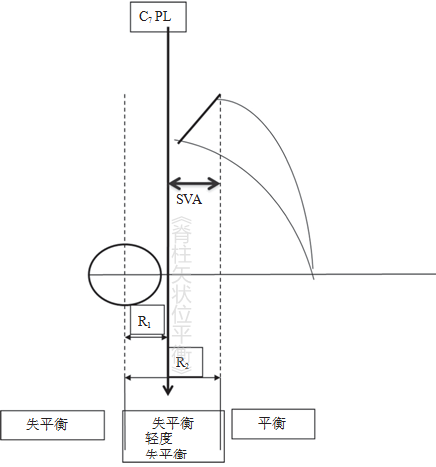
图5-12 C7铅垂线测量距离
矢状位垂直轴距离单位是毫米(mm)。Barrey比值(R1/R2)表述为C7PL的相对位置
但C7铅垂线位于骶骨上终板后方,此比例大于1,脊柱为平衡状态。
当C7铅垂线位于股骨头和骶骨后上缘之间,此比例在0~1之间,脊柱平衡有改变。
如果C7铅垂线位于股骨头前方,脊柱失平衡。
研究者们喜欢应用角度或距离比,因为这些参数不容易在X线片中出现校准错误。此外为避免这些问题很多测量方法都被提出过,但是只有一种方法被广泛接受,即T1骨盆角(T1 pelvic angle,T1PA),该角度为T1椎体和股骨头中点连线,同股骨头中点和骶骨上终板中点连线之间的夹角。它的角分量分别是PT和T1脊柱骨盆角。尽管不需要校准,但是该角度仍然很难测量出T1PA的微小变化,而且其可信性也不如SVA强[3,33]。
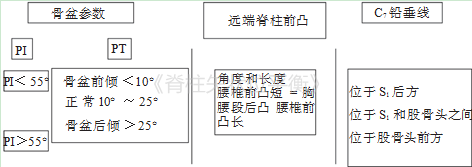
图5-13 应用矢状位平衡参数计算平衡方法
①骨盆倾入射角水平;②骨盆倾斜角水平;③腰椎前凸长度和角度;④C7PL相对于股骨头和骶骨上终板的位置
总结
对于脊柱平衡而言,没有任何一个外科相关的客观影像学参数比临床客观指标更有意义,而临床标准为最低耗能,安全的情况下就保持直立位。总之,如果脊柱在能量圆锥之内可以实现这个目标。然而外科医师经常发现,尝试让老年患者“矫形成为相对年轻”的脊柱获得一个良好立线的过程不仅是有风险且是耗时的,也可能是不恰当的,这样可能使患者面临新的问题如近端交界性后凸。
有相当多的证据表明重建或者改善脊柱矢状位平衡会带来更好的术后临床结果和生活质量。然而,以恢复脊柱矢状面平衡为主要目的的手术,无论采用传统的还是所谓的“微创”方式,都具有较高并发症发生率,主要并发症的发生率高达70%,死亡率也很高[34,35]。
有着重要临床意义的测量方法已经被SRS-Schwab成人脊柱畸形分型所总结出来,其中PI-LL不匹配、SVA和PT角具有重要临床相关性[21]。研究人员发现,将评估局限于这些参数有时可能无法充分理解颈、胸段畸形,并强调了相信的临床检查的重要性。
一些情况下,如患者身体非常虚弱或者伴有骨质疏松症时,就无法重建全脊柱的立线;相反,一些年轻患者(50岁或60岁左右)因为身体情况较好,骨密度良好,长节段的融合固定术就会有很好的效果。一般情况下,患者及外科医师的预期值应结合矢状面平衡情况而进行调整,并为围术期做好术前规划[36]。
结论
本章并非要对ADSD进行一个详细的系统性分析,而是一个简略的回顾,以期帮助进行手术计划和评估。基于此,我们特别省略了一些外科医师仍然坚持使用的陈旧的形态学测量法和概念。随着临床证据的不断积累和学术的广泛交流,新的概念逐渐被越来越多的外科医师所接受并应用临床,这里所引用的测量法一定还会继续发展。尽管5~6年不会被广泛应用,但是随着技术不断进步,这种情况会不断改善。
每一名脊柱外科医师无论参与ADSD治疗与否,都应关注脊柱矢状位平衡情况。我们必须避免将ADSD进一步变成医源性脊柱畸形,因为医源性脊柱畸形将更加难以处理。即便制订短节段融合固定手术计划可能已经足够,也必须根据实际情况调整期望值[36]。
在不久的将来,由于医疗费用、医疗资源以及手术技巧的需要,ADSD手术可能仍然是一个具有显著区域差异的专业领域。但即使是“相对简单”的腰椎间盘突出症或一度脊柱滑脱症病例,对每个患者脊柱平衡性进行评估都是必要的,否则可能导致其多年后发展为医源性畸形,从而进行更长节段的脊柱固定融合术。
再次提醒外科医师要充分理解这些概念,因为无论是无症状患者还是需要手术患者,脊柱整体矢状位平衡在正常人群中都存在巨大差异,如一个驼背的患者可能并无明显的临床症状。总的来说,一个准确翔实的患者问诊和临床评估不仅非常重要,而且可能比单一或一系列的影像学评估方法更重要。(完)
参考文献:
[1] Barrey C. Equilibre Sagittal Pelvi-Rachidien et Pathologies Lombaires Degeneratives [these doctorat], Université Claude-Bernard, Lyon, France; 2004
[2] Mac-Thiong J-M, Pinel-Giroux F-M, de Guise JA, Labelle H. Comparison between constrained and non-constrained Cobb techniques for the assessment of thoracic kyphosis and lumbar lordosis. Eur Spine J. 2007; 16 (9):1325–1331
[3] Mac-Thiong J-M, Roussouly P, Berthonnaud E, Guigui P. Sagittal parameters of global spinal balance: normative values from a prospective cohort of seven hundred nine Caucasian asymptomatic adults. Spine. 2010; 35(22): E1193–E1198
[4] Vedantam R, Lenke LG, Bridwell KH, Linville DL, Blanke K. The effect of variation in arm position on sagittal spinal alignment. Spine. 2000; 25(17): 2204–2209
[5] Marks MC, Stanford CF, Mahar AT, Newton PO. Standing lateral radiographic positioning does not represent customary standing balance. Spine. 2003; 28 (11):1176– 1182
[6] Rillardon L, Levassor N, Guigui P, et al. Validation of a tool to measure pelvic and spinal parameters of sagittal balance (in French). Rev Chir Orthop Reparatrice Appar Mot. 2003; 89(3):218–227
[7] Bari JT, Hallager DW, Tøndevold N, et al. Moderate inter-rater and substantial intra- rater reproducibility of the Roussouly Classification System in patients with adult spinal deformity. Spine Deform. 2019; 7(2):312–318. doi: 10.1016/j.jspd.2018.08.009.
[8] Vialle R, Ilharreborde B, Dauzac C, Guigui P. Intra and inter-observer reliability of determining degree of pelvic incidence in high-grade spondylolisthesis using a computer assisted method. Eur Spine J. 2006; 15(10):1449–1453
[9] Dimar JR, II, Carreon LY, Labelle H, et al. Intra- and inter-observer reliability of determining radiographic sagittal parameters of the spine and pelvis using a manual and a computer-assisted methods. Eur Spine J. 2008; 17(10): 1373–1379
[10] Yamada K, Aota Y, Higashi T, Ishida K, Nimura T, Saito T. Accuracies in measuring spinopelvic parameters in full-spine lateral standing radiograph. Spine. 2015; 40(11):E640–E646
[11] Legaye J, Duval-Beaupère G, Hecquet J, Marty C. Pelvic incidence: a fundamental pelvic parameter for three-dimensional regulation of spinal sagittal curves. Eur Spine J. 1998; 7(2):99–103
[12] Lee J-H, Na K-H, Kim J-H, Jeong H-Y, Chang D-G. Is pelvic incidence a constant, as everyone knows? Changes of pelvic incidence in surgically corrected adult sagittal deformity. Eur Spine J. 2016; 25(11):3707–3714
[13] Duval-Beaupère G, Robain G. Visualization on full spine radiographs of the anatomical connections of the centres of the segmental body mass supported by each vertebra and measured in vivo. Int Orthop. 1987; 11(3):261–269
[14] During J, Goudfrooij H, Keessen W, Beeker TW, Crowe A. Toward standards for posture. Postural characteristics of the lower back system in normal and pathologic conditions. Spine. 1985; 10(1):83–87
[15] Roussouly P, Gollogly S, Berthonnaud E, Dimnet J. Classification of the normal variation in the sagittal alignment of the human lumbar spine and pelvis in the standing position. Spine. 2005; 30(3):346–353
[16] Duval-Beaupère G, Schmidt C, Cosson P. A barycentremetric study of the sagittal shape of spine and pelvis: the conditions required for an economic standing position. Ann Biomed Eng. 1992; 20(4):451–462
[17] Jean L. Influence of age and sagittal balance of the spine on the value of the pelvic incidence. Eur Spine J. 2014; 23(7):1394–1399
[18] Skalli W, Zeller RD, Miladi L, et al. Importance of pelvic compensation in posture and motion after posterior spinal fusion using CD instrumentation for idiopathic scoliosis. Spine. 2006; 31(12):E359–E366
[19] Janssen MMA, Drevelle X, Humbert L, Skalli W, Castelein RM. Differences in male and female spino-pelvic alignment in asymptomatic young adults: a three-dimensional analysis using upright low-dose digital biplanar X-rays. Spine. 2009; 34(23):E826–E832
[20] Vialle R, Levassor N, Rillardon L, Templier A, Skalli W, Guigui P. Radiographic analysis of the sagittal alignment and balance of the spine in asymptomatic subjects. J Bone Joint Surg Am. 2005; 87(2):260–267
[21] Terran J, Schwab F, Shaffrey CI, et al. The SRS Schwab adult spinal deformity classification: assessment and clinical correlations based on a prospective operative and nonoperative cohort. Neurosurgery. 2013; 73(4):559–568
[22] Le Huec JC, Aunoble S, Philippe L, Nicolas P. Pelvic parameters: origin and significance. Eur Spine J. 2011; 20 Suppl 5:564–571
[23] Roussouly P, Pinheiro-Franco JL. Biomechanical analysis of the spino-pelvic organization and adaptation in pathology. Eur Spine J. 2011; 20 Suppl 5:609– 618
[24] Ames CP, Smith JS, Eastlack R, et al. Reliability assessment of a novel cervical spine deformity classification system. J Neurosurg Spine. 2015; 23(6): 673–683
[25] Schwab FJ, Blondel B, Bess S, et al. Radiographical spinopelvic parameters and disability in the setting of adult spinal deformity: a prospective multicenter analysis. Spine. 2013; 38(13):E803–E812
[26] Berthonnaud E, Dimnet J, Roussouly P, Labelle H. Analysis of the sagittal balance of the spine and pelvis using shape and orientation parameters. J Spinal Disord Tech. 2005; 18(1):40–47
[27] Roussouly P, Berthonnaud E, Dimnet J. Geometrical and mechanical analysis of lumbar lordosis in an asymptomatic population: proposed classification (in French).Rev Chir Orthop Reparatrice Appar Mot. 2003; 89(7):632–639
[28] Boulay C, Tardieu C, Hecquet J, et al. Sagittal alignment of spine and pelvis regulated by pelvic incidence: standard values and prediction of lordosis. Eur Spine J. 2006; 15(4):415–422
[29] Kuntz C, IV, Levin LS, Ondra SL, Shaffrey CI, Morgan CJ. Neutral upright sagittal spinal alignment from the occiput to the pelvis in asymptomatic adults: a review and resynthesis of the literature. J Neurosurg Spine. 2007; 6(2): 104–112
[30] Schwab FJ, Hawkinson N, Lafage V, et al. Risk factors for major peri-operative complications in adult spinal deformity surgery: a multi-center review of 953 consecutive patients. Eur Spine J. 2012; 21(12):2603–2610
[31] Roussouly P, Gollogly S, Noseda O, Berthonnaud E, Dimnet J. The vertical projection of the sum of the ground reactive forces of a standing patient is not the same as the C7 plumb line: a radiographic study of the sagittal alignment of 153 asymptomatic volunteers. Spine. 2006; 31(11):E320–E325
[32] Obeid I, Boissière L, Yilgor C, et al. Global tilt: a single parameter incorporating spinal and pelvic sagittal parameters and least affected by patient positioning. Eur Spine J. 2016; 25(11):3644–3649
[33] Protopsaltis T, Schwab F, Bronsard N, et al. TheT1 pelvic angle, a novel radiographic measure of global sagittal deformity, accounts for both spinal inclination and pelvic tilt and correlates with health-related quality of life. J Bone Joint Surg Am. 2014; 96(19):1631–1640
[34] Haque RM, Mundis GM, Jr, Ahmed Y, et al. Comparison of radiographic results after minimally invasive, hybrid, and open surgery for adult spinal deformity: a multicenter study of 184 patients. Neurosurg Focus. 2014; 36(5):E13
[35] Smith JS, Shaffrey CI, Glassman SD, et al. Clinical and radiographic parameters that distinguish between the best and worst outcomes of scoliosis surgery for adults. Eur Spine J. 2013; 22(2):402–410
[36] Fontes RB, Fessler RG. Lumbar radiculopathy in the setting of degenerative scoliosis: MIS decompression and limited correction are better options. Neurosurg Clin N Am. 2017; 28(3):335–339
来源:《脊柱矢状位平衡》
翻译:韩超凡 周立金
校对:刘玉增 海 涌
主译:海 涌 李 利 李危石 郑召民
主审:邱 勇 吕国华
点击下图查看书籍简介↓
声明:此文内容及图片由供稿单位提供,仅供学习交流,不代表骨科在线观点。
相关阅读:





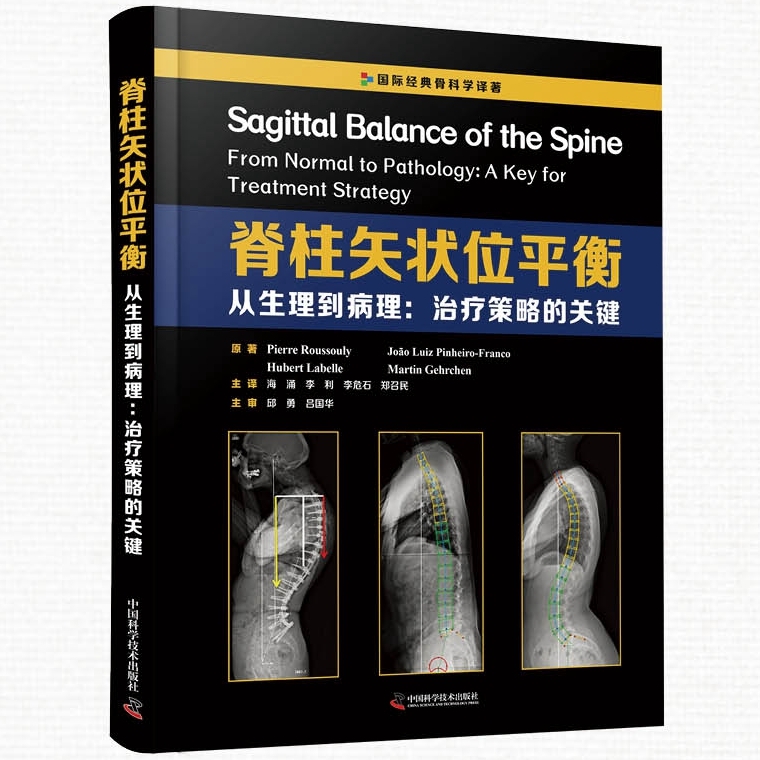
 京公网安备11010502051256号
京公网安备11010502051256号